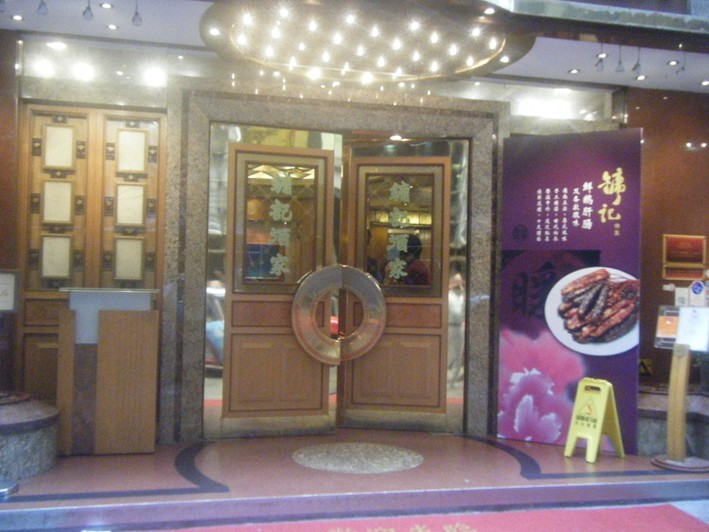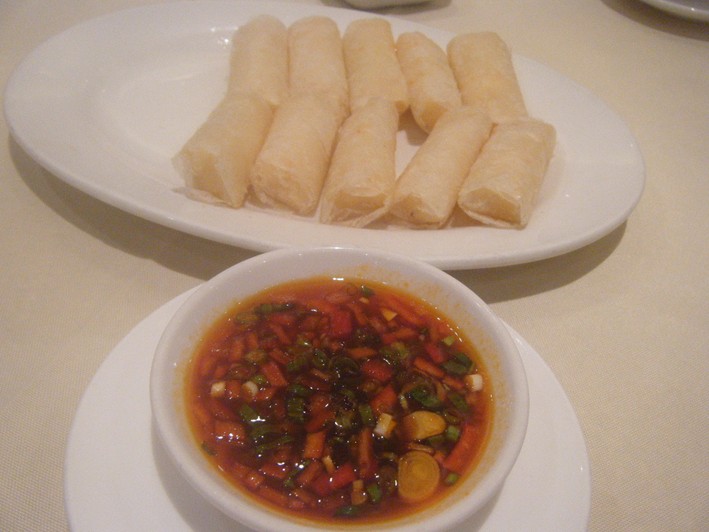Yung Kee is a Hong Kong institution, open since 1942. Of course Broadmoor is also an institution, and that doesn’t mean that you want to go there. It is a multi-storey, bustling affair, with tightly packed tables that were heaving with diners at the lunch that we visited. While there are proper yellow tablecloths we didn’t get any napkins, and service was of the London Chinatown variety of rushed heckling.
Deep fried shrimp rolls appeared as pale with a light batter and a decent sweet chilli sauce (12/20). Sautéed scallops were properly cooked with a little ginger and some rather soggy gai lan (14/20 if I politely ignore the gai lan). Vegetables with crab meat was not a pleasant dish, the crab flavour lost in an unidentified slimy white sauce (10/20). Better were respectable Singapore noodles, crude than some but at least with a little bit of chilli bite (12/20). Rice was fine, but quite how this place has such a reputation is beyond me based on this lunch.
Perhaps it was leader of the pack in 1942, but that doesn’t explain why Michelin gave it a star in 2009. The bill per person for lunch, with tea and no other drinks was HK$ 313.














ulterior epicure
@ geniuiness: I haven't read your review yet. But I will have to say that my visit to Yung Kee was just about as satisfying as Hayler's. And I DID get the roast duck. And I DID eat on the 4th floor "VIP."
Richard
That's an inherent problem with Chinese restaurants. Chinese cooking technique are very "personal" and kind of like Jazz which I mean is more art and improvisation then classical music where the score is set. For example, ten different chefs cooking the same stir fired dish will end up with ten different (even though slightly) variation like amount of sauce, doneness of the ingredient, etc because the margin of error is very narrow and those differences contribute to different characters of the final dish. That’s why regulars get the head chef to cook a great dish for them while regular Joe just gets regular results for the same dish cooked by the lower ranked chefs. This is a known problem when you go to large restaurants and that’s why the best restaurants are usually smaller or have “special” VIP segments where the restaurant put their top talent to serve those demanding clientele. In Hong Kong, "knowing how and what to order in restaurants" is a social asset and better yet, if you know the owner or chef, you are usually guaranteed a better meal. Similar to a Japanese restaurant where the regulars always get the better cut of the fish, Chinese restaurants are no different. I felt that you didn’t get the best experience you deserved in these restaurants, so my proposal is that next time you plan to visit Hong Kong again. You should gather a group of fellow food blogger enthusiast to share a meal together (I always do when I visit Hong Kong). After all, Chinese food is best shared and with a group of 8-12. This way you can have the best variety and progression of dishes similar to a tasting menu. In European cuisine, the progression of a meal is usually guided with a somewhat fixed menu (appetizer, main, dessert, etc) but this is generally not the case in Chinese cuisine and a bad meal can often happen because of poor ordering. Haute Chinese cuisine has specific progression of dishes that build up the whole dining experience. If you attend a Chinese banquet, you will understand what I mean. Ordering haute Chinese cuisine is an art involving understanding the proper progression of dishes and the technique of dishes involved so that you won’t have a fried dish after another or a succession of steamed dishes. Even cooking technique can have diminishing return.
Richard
I think the problem with restaurnat of this size is that quality of food cannot be as consistant as it needs to be. For example, if you go to fourth floor of Yung Kee, you will have a much different dining experience. (Think about it is the difference between a casual bistro and the restaurant within the same building by the same owner) The dishes are quite different as well. See below for the dishes in my blog. http://www.vintnersgroup.com/Food%20blog/yung%20kee/index.html
gen.u.ine.ness
andy.. you completely missed the point of visiting Yung Kee. The place is famous for one thing and one thing only - their Roast Goose. I suppose there are other things which is pretty good there like their century egg, an acquired taste especially with caucasian as well as other weird and wonderful dishes chinese people love. (Speaking of the goose, the quality of the roast goose you get is based on well... how loyal a customer you are, or how much you are willing to shell for a VIP dining room) I did a review of yung kee (and other restaurants in HK) last summer before the michelin guide was released (http://genuiness.wordpress.com)